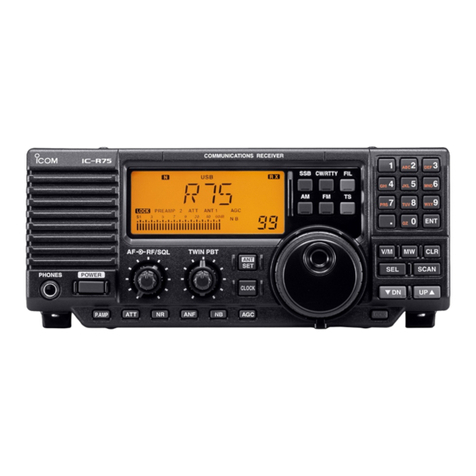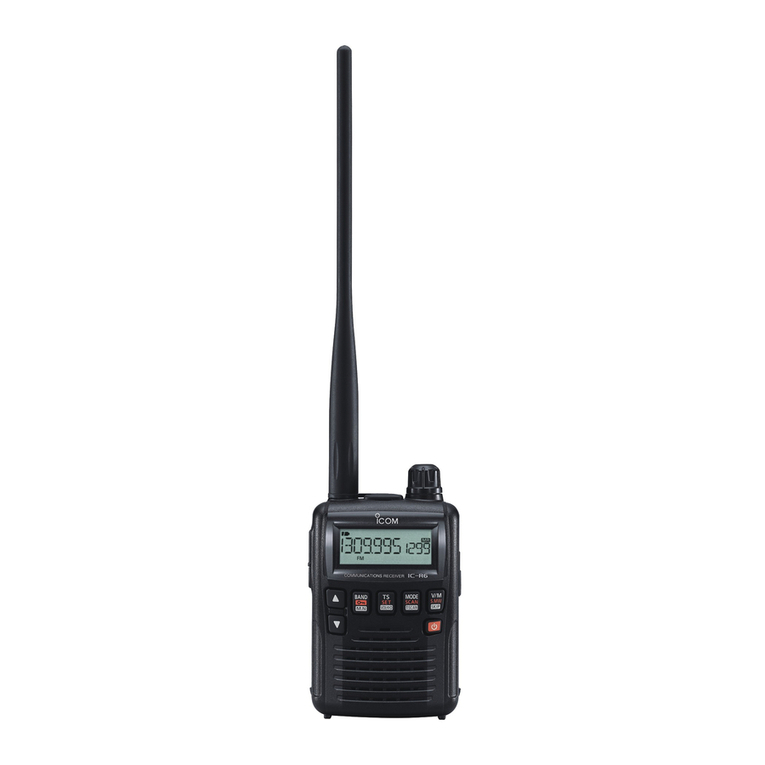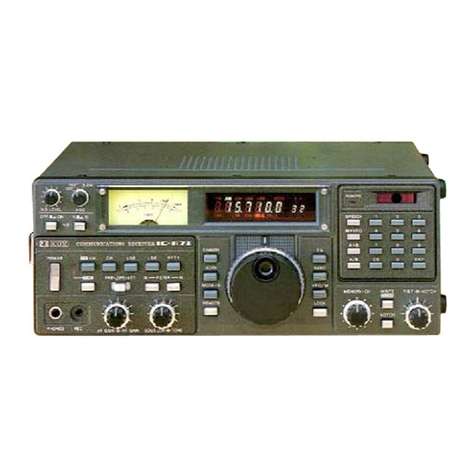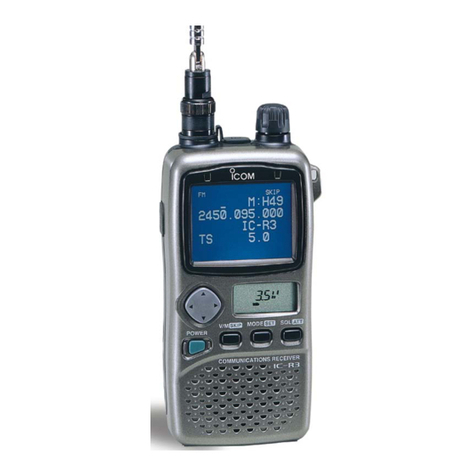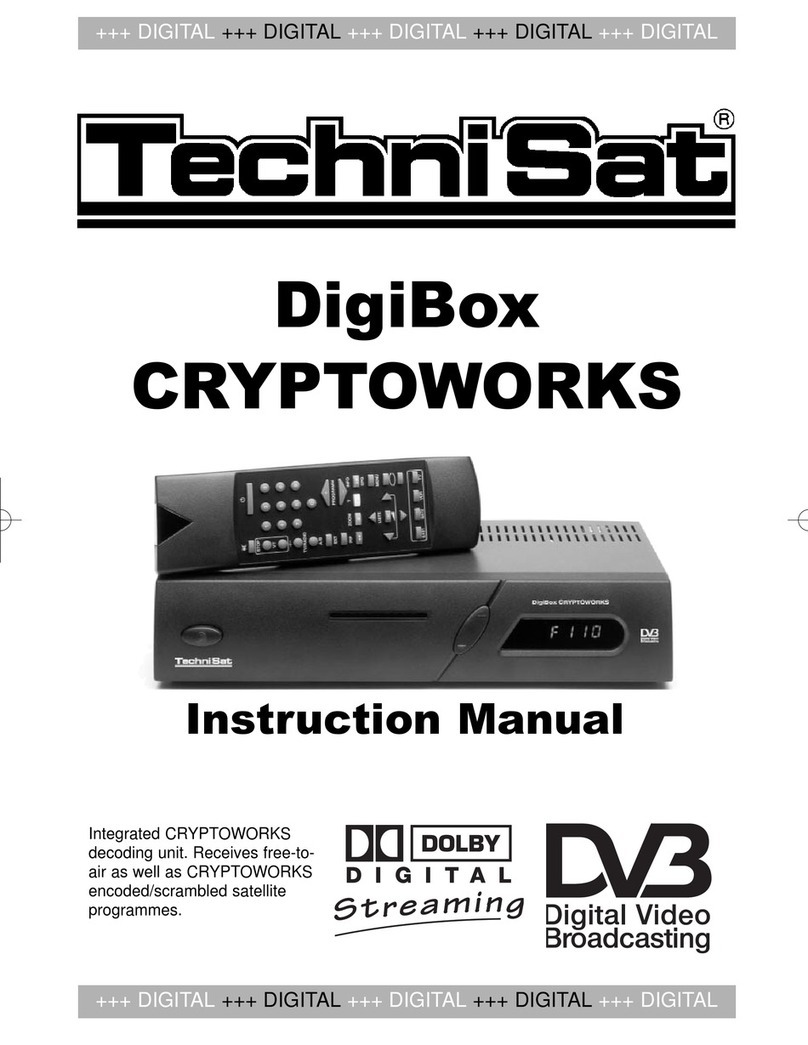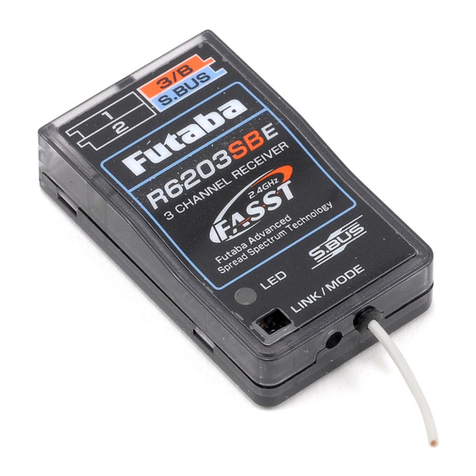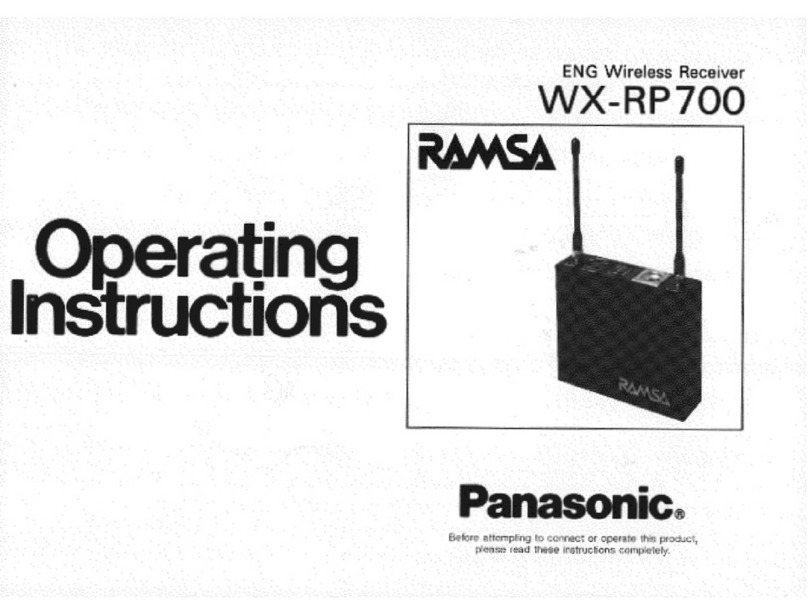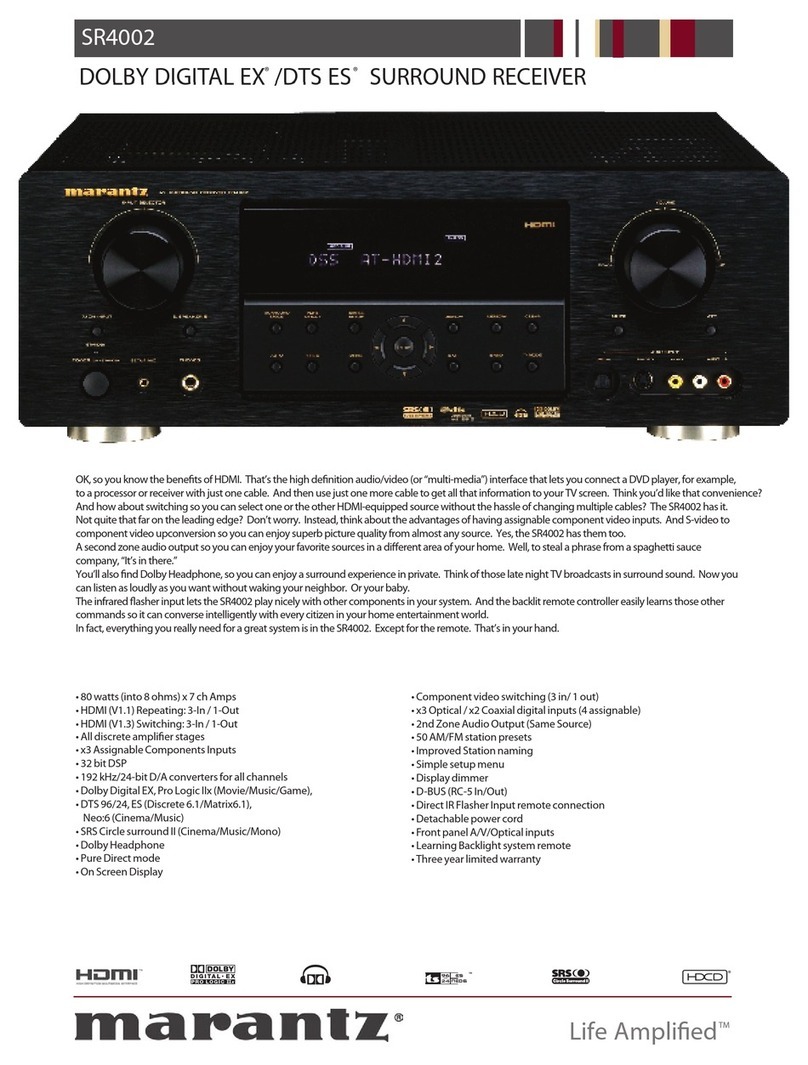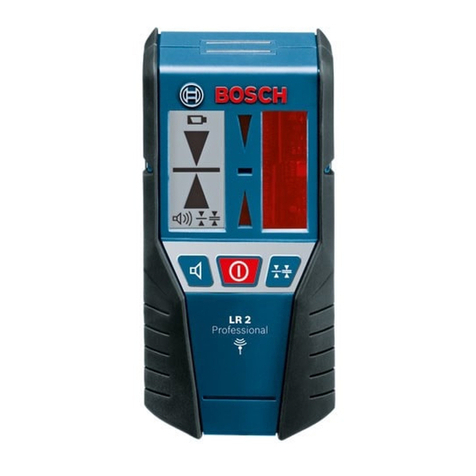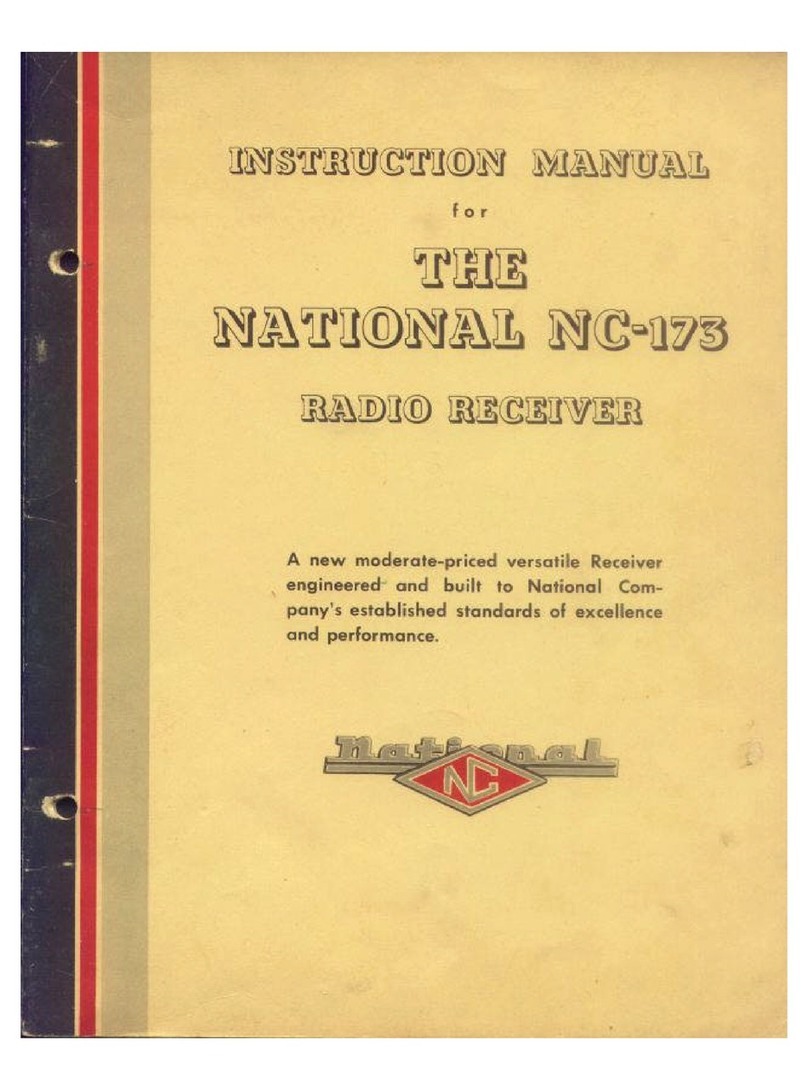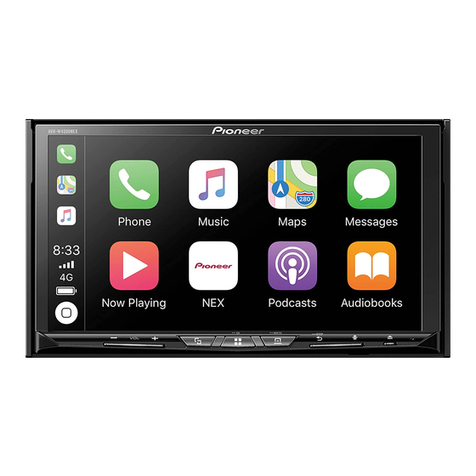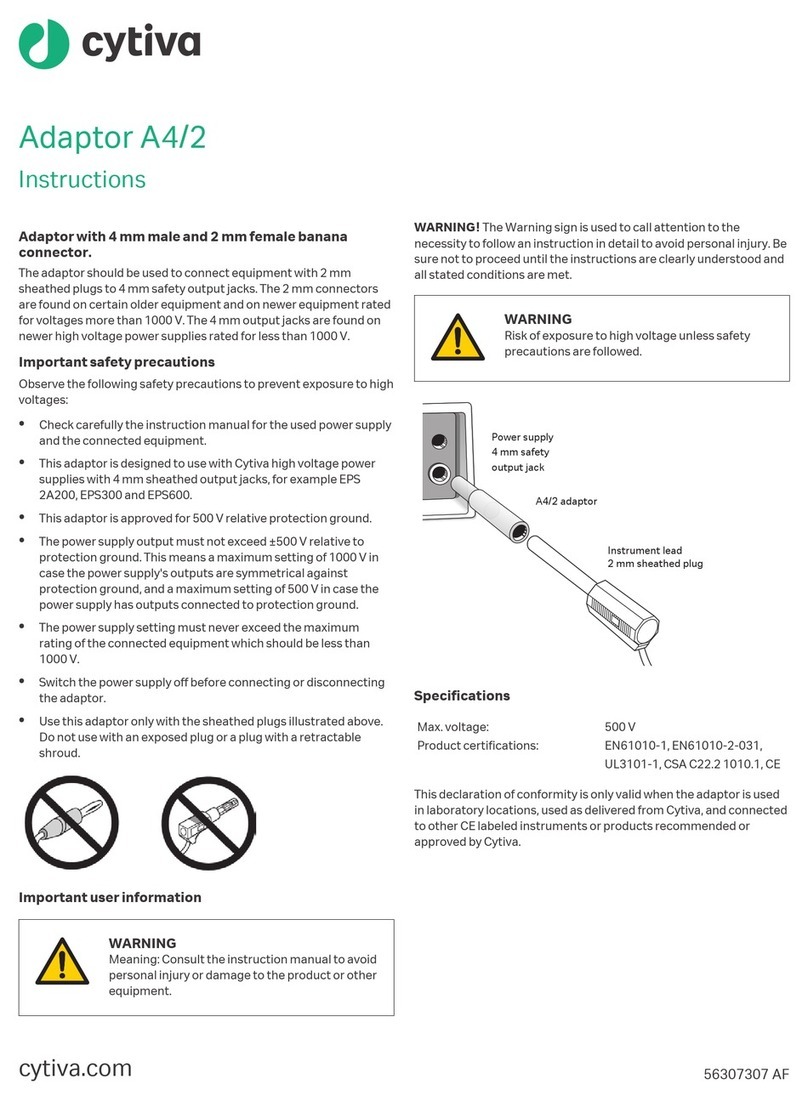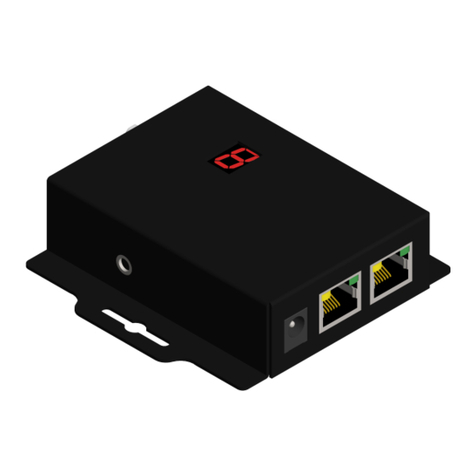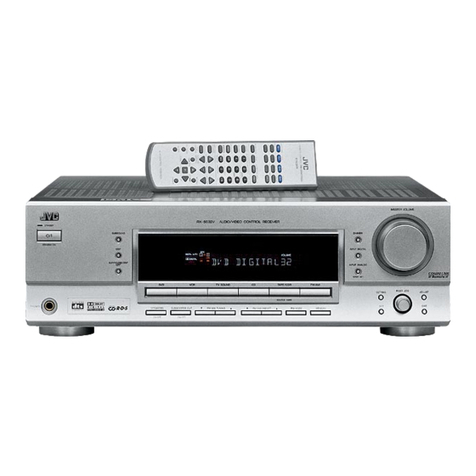Icom IC-R2500 User manual

INSTRUCTION MANUAL
iR2500
COMMUNICATION RECEIVER
This device complies with Part 15 of the FCC rules. Operation is sub-
ject to the following two conditions: (1) This device may not cause
harmful interference, and (2) this device must accept any interference
received, including interference that may cause undesired operation.

i
FOREWORD
Thank you for purchasing this Icom product. The IC-R2500
VHF
/
UHF FM RECEIVER
is designed and built with Icom’s supe-
rior technology and craftsmanship. With proper care, this prod-
uct should provide you with years of trouble-free operation.
We want to take a couple of moments of your time to thank
you for making your IC-R2500 your radio of choice, and hope
you agree with Icom’s philosophy of “technology first.” Many
hours of research and development went into the design of
your IC-R2500.
DD
FEATURES
❍Wide frequency coverage with all mode re-
ceive
❍Both Remote controller operation and PC
control application are available
❍
ANF and NR functions are available (Only
when the optional DSP unit is installed.)
❍IF shift function
IMPORTANT
READ ALL INSTRUCTIONS carefully and completely
before using the receiver.
SAVE THIS INSTRUCTION MANUAL— This in-
struction manual contains important operating instructions for
the IC-R2500.
EXPLICIT DEFINITIONS
WORD DEFINITION
RWARNING!
CAUTION
NOTE
Personal injury, fire hazard or electric shock
may occur.
Equipment damage may occur.
Recommended for optimum use. No risk of
personal injury, fire or electric shock.
Icom, Icom Inc. and the logo are registered trademarks of Icom
Incorporated (Japan) in the United States, the United Kingdom, Ger-
many, France, Spain, Russia and/or other countries.

RWARNING! NEVER connect the receiver via the OPC-
254L to anAC outlet. This may pose a fire hazard or result in an elec-
tric shock.
RWARNING! NEVER operate the receiver while driving a
vehicle. Safe driving requires your full attention— anything less may
result in an accident.
NEVERconnect the receiver to a power source of more than 14 V
DC. This will damage the receiver.
NEVERconnect the receiver to a power source using reverse po-
larity. This will damage the receiver.
NEVER cut the DC power cable between the DC plug and fuse
holder. If an incorrect connection is made after cutting, the receiver
may be damaged.
NEVER expose the receiver to rain, snow or any liquids. The re-
ceiver may be damaged.
NEVER operate or touch the receiver with wet hands. This may
result in an electric shock or damage the receiver.
NEVER place the receiver where normal operation of the vehicle
may be hindered or where it could cause bodily injury.
NEVER let objects impede the operation of the cooling fan on the
rear panel.
AVOID using or placing the receiver in direct sunlight or in areas
with temperatures below –10°C (+14°F) or above +60°C (+140°F).
BE CAREFUL!The receiver will become hot when operating it
continuously for long periods.
AVOID setting the receiver in a place without adequate ventilation.
Heat dissipation may be affected, and the receiver may be damaged.
AVOID the use of chemical agents such as benzine or alcohol
when cleaning, as they can damage the receiver’s surfaces.
For U.S.A. only
CAUTION: Changes or modifications to this device, not ex-
pressly approved by Icom Inc., could void your authority to
operate this device under FCC regulations.
ii
PRECAUTION

iii
TABLE OF CONTENTS
FOREWORD ........................................................................................... i
IMPORTANT ............................................................................................ i
EXPLICIT DEFINITIONS ......................................................................... i
PRECAUTIONS ...................................................................................... ii
SUPPLIED ACCESSORIES .................................................................. iii
SPECIFICATIONS ................................................................................. iii
OPTIONS ............................................................................................... iii
TABLE OF CONTENTS ......................................................................... iii
1CONNECTION .............................................................................. 1–2
■Rear panel connection.................................................................... 1
■Antenna installation ........................................................................ 2
2PANEL DESCRIPTION ................................................................. 3–7
■Front panel—controller .................................................................. 3
■Function display—controller ........................................................... 5
■Rear panel—main unit ................................................................... 7
3SETTING A FREQUENCY .......................................................... 8–10
■Turning power ON/OFF ................................................................. 8
■Mode selection ............................................................................... 8
■Tuning step selection ..................................................................... 9
■Setting a frequency ........................................................................ 9
■Receive mode selection ............................................................... 10
4BASIC OPERATION ................................................................. 11–15
■Receiving ..................................................................................... 11
■Monitor function ............................................................................ 11
■Lock function ................................................................................ 11
■Attenuator function........................................................................ 12
■NB function .................................................................................. 12
■AGC function ................................................................................ 12
■AFC function ................................................................................ 13
SUPPLIED ACCESSORIES
Supplied accessories is described in the IC-PCR1500/2500’s
Instruction manual.
OPTIONS
UT-106*
DSP UNIT
Provides AF DSP functions such as noise reduction and auto notch.
CP-12L
CIGARETTE LIGHTER CABLES
For operation and charging via a 12 V cigarette lighter socket.
OPC-254L
DC POWER CABLES
For operation and charging via an external power supply.
SP-10
EXTERNAL SPEAKER
For all-round mobile operation. Cable length: 1.5 m; 4.9 ft
OPC-1156
SEPARATION CABLE
For extended separate installation. 3.5 m; 11.5 ft
*: UT-106 installation is described in the IC-PCR1500/2500’s Instruc-
tion manual.
SPECIFICATIONS
Specifications is described in the IC-PCR1500/2500’s In-
struction manual.

iv
1
2
3
4
5
6
7
8
9
10
11
12
13
14
■VSC function ................................................................................ 13
■IF filter selection ........................................................................... 14
■IF shift function ............................................................................. 14
■Duplex operation .......................................................................... 15
5MEMORY OPERATION ............................................................ 16–24
■General description ...................................................................... 16
■Memory channel selection ........................................................... 16
■Programming a memory channel ................................................. 17
■Programming channel names ..................................................... 18
■Copying memory contents ........................................................... 19
■Memory clearing .......................................................................... 21
■Memory bank setting .................................................................... 22
■Memory bank selection ................................................................ 23
■Transferring bank contents .......................................................... 23
6SCAN OPERATION .................................................................. 25–29
■Scan types ................................................................................... 25
■Scan start/stop ............................................................................. 26
■Scan edges programming ............................................................ 27
■Skip scan ..................................................................................... 28
■Scan resume condition ................................................................ 29
7PRIORITY WATCH .......................................................................... 30
■Priority watch types ...................................................................... 30
■Priority watch operation ............................................................... 30
8POCKET BEEP AND TONE SQUELCH ................................... 31–34
■Pocket beep operation ................................................................. 31
■Tone/DTCS squelch operation ..................................................... 33
■Tone scan ..................................................................................... 34
9SET MODE ................................................................................ 35–41
■General ........................................................................................ 35
■Set mode items ............................................................................ 35
10 OTHER FUNCTIONS ................................................................ 42–46
■Weather channel operation .......................................................... 42
■DSP operation .............................................................................. 43
■DATA cloning ................................................................................ 44
■Partial reset................................................................................... 45
■All reset......................................................................................... 45
■Internal audio switch..................................................................... 46
11 TROUBLESHOOTING .................................................................... 47
12 DOC ................................................................................................. 48

1
CONNECTION
1
■Rear panel connection DDC power supply connection
Use a 12 V DC power supply with at least 4 A capacity.
Make sure the ground terminal of the DC power supply is
grounded.
•CONNECTING TO A DC POWER SUPPLY
OPC-254L
(optional)
black
white
RCAUTION! NEVER remove the fuse-
holders from the DC power cable.
Connects to a 12 V DC
battery. Pay attention
to polarities. NEVER
connect to a 24 V bat-
tery. This could dam-
age the receiver.
Solder
Crimp
NOTE: Use the terminals as shown
below for the cable connections.
DFuse replacement
Receiver
Fuses (4 A)
DC power
supply 12 V
to an
AC outlet
−⊕
Ferrite core
Controller
CP-12L
(optional)
To a cigarette lighter socket
Fuse (4 A)
Or
Receiver
To ground
Supplied antenna
The double sided tape is set to the antenna holder.
Remove the protective paper when the antenna is
fixed to any place.
To AC adapter

2
1
CONNECTION
2
DDOPC-1156 connection
qConnect the controller plug to the OPC-1156 joint.
wDetach the ferrite core from the controller cable, then at-
tach it to the OPC-1156 as shown below.
• Make sure to roll the cable to the ferrite core.
eConnect the OPC-1156 plug to the [CONTROLLER] con-
nector of the receiver.
■Antennal installation
DAntenna location
To obtain maximum performance from the receiver, select a
high-quality antenna and mount it in a good location. A non-
radial antenna should be used when using a magnetic mount.
Receiver
Controller
Joint
Ferrite core

3
PANEL DISCRIPTION
2
■Front panel— controller
qPOWER KEY [PWR•]
➥Turns the controller power ON and OFF when pushed
and held for 1 sec.
➥Continue to hold this key down for 2 sec. after power
ON to turn the lock function ON and OFF. (p. 15)
wSET•SKIP KEY [SET•SKIP]
➥Enters set mode when pushed. (p. 56)
➥Push and hold for 1 sec. to turn the channel skip setting
ON and OFF for memory/VFO skip scan operation.
(p. ??)
eMONITOR•TONE•TONE SCAN SWITCH
[MONI•T/T-SCAN]
➥Push to turn the monitor function ON and OFF. (p. ??)
➥Push and hold for 1 sec. to enter the tone function se-
lection mode. (pgs. ??, ??)
•Subaudible tone encoder, pocket beep (CTCSS), tone
squelch, pocket beep (DTCS), DTCS squelch or tone func-
tion OFF can be selected.
➥Push and hold for 1 sec. during tone function selection
mode to start the tone scan. (p. ??)
rMODE•SCAN SWITCH [MODE•SCAN]
➥Push and hold for 1 sec. to enter the mode selection
condition. (p. ??)
•Rotate [DIAL] to select the desired operating mode..
➥Starts scan when pushed and held for 1 sec. (p. ??)
•Cancels a scan when pushed during scan.
tATTENUATOR/PRIORITY SWITCH [ATT•PRIO]
➥Push to turn theATT (Attenuator) function ON and OFF.
MAIN
AGC
S.MW
TS
VFO/MR
MHz
MAIN
NB
S.MW
VFO/MR
TS
MHz
VOLVOL
DIALDIAL SQLSQL
MONI
T/T-SCAN
MODE
SCAN ATT
PRIO
COMMUNICATIONS RECEIVER
iR2500
PWR SET
SKIP
Function display (pgs. 3, 4)
qw
ert
*The keys wto tare for
the MAIN band only.

4
2
PANEL DESCRIPTION
1
2
3
4
5
6
7
8
9
10
11
12
13
14
15
16
(p. ??)
➥Starts priority watch when pushed for 1 sec. (p. ??)
ya MAIN•AGC KEY [MAIN•AGC]
➥Push to select the main band. (p. 11)
➥Push for 1 sec. to turn the AGC (Automatic Gain Con-
trol) function ON and OFF. (p. ??)
yb MAIN•NB KEY [MAIN•NB]
➥Push to select the main band. (p. 11)
➥Push for 1 sec. to turn the NB (Noise Blanker) function
ON and OFF. (p. ??)
u
VFO/MEMORY•MEMORY WRITE KEY [VFO/MR•S.MW]
➥Push to select and toggle VFO, memory and weather
channel* modes. (pgs. 12, 29, 38, 65)
*Weather channels available for USAversions only.
➥Selects a memory channel for programming when
pushed for 1 sec. (pgs. 30, 39, 42)
iMHz TUNING•TUNING STEP [MHz•TS]
➥Selects band selection, 1 MHz or 10 MHz tuning when
pushed. ((p. 9))
➥Push and hold for 1 sec. to enter the tuning step selec-
tion mode. (p. ??)
•Rotate [DIAL] to select the desired tuning step.
oVOLUME CONTROL [VOL] (p. 16)
Adjusts the audio level for relative band.
!0TUNING DIAL [DIAL]
Selects the operating frequency (p. 13), memory channel
(p. 29), the setting of the set mode item and the scanning
direction (p. 41) for the relative band.
!1SQUELCH CONTROL [SQL]
Varies the squelch level for relative band. (p. 16)
MAIN
AGC
S.MW
TS
VFO/MR
MHz
MAIN
NB
S.MW
VFO/MR
TS
MHz
VOLVOL
DIALDIAL SQLSQL
MONI
T/T-SCAN
MODE
SCAN ATT
PRIO
COMMUNICATIONS RECEIVER
iR2500
PWR SET
SKIP
Left band Right band
oo
yb
u
i
!0
ya
u
i
!0
!1!1
*The same controls for both the left and
right bands are arranged in symmetry.

5
2PANEL DESCRIPTION
■Function display
qMAIN INDICATOR (p. 11)
Indicate the main band for transmit and function control.
wRECEIVE MODE INDICATORS FOR ANALOG
Shows the selected receive mode.
•SSB (LSB/USB), CW,AM and FM (FM/WFM) are available.
eRECEIVE MODE INDICATOR FOR DIGITAL
Appears while the digital mode is selected..
•DiGITAL mode is available dependes on versions.
rAUTO POWER-OFF INDICATOR ((p. 36))
Appears while the auto power OFF function is in use.
yFREQUENCY READOUT
Shows the operating frequency, channel names, set mode
contents, etc.
•Frequency decimal point blinks while scanning. ((p. 26))
uMEMORY CHANNEL NUMBER INDICATORS
➥Shows the selected memory channel number. ((p. 16))
➥Shows the selected bank initial. ((p. 23))
➥“L” appears when the lock function is activated. ((p. 11))
Left band Right band
t
t
!3
qewqewr
yyuuoo!0!0
!2
!1!1 ii
!4
!3
!4
!2
*The same indications for both the left and right
bands are arranged.

6
2
PANEL DESCRIPTION
2
iSKIP INDICATORS ((p. 28))
➥“~” appears when the displayed memory channel is
specified as a skip channel.
➥“
P
~” appears when the displayed frequency is speci-
fied as a program skip frequency.
iMEMORY INDICATOR (pgs. 12, 29)
Appears when memory mode is selected.
oVSC INDICATOR ((p. 13))
Appears when the VSC function is in use.
!0S-METER INDICATORS
Shows the relative signal strength while receiving signals.
((p. 11))
!1TONE INDICATORS
➥While FM mode operation:
●
●
“”appears while the tone squelch function is in use.
((p. 16))
●
●
“”appears while the DTCS squelch function is in
use. ((p. 16))
➥While DV (Digital) mode operation:
●
●
“”appears while the digital call sign squelch func-
tion is in use. ((p. 16))
●
●
“”appears while the digital code squelch function
is in use. ((p. 16))
➥“S” appears with the “ ” or “ ” indicator while the
pocket beep function is in use.
!2PRIORITY INDICATOR ((p. 30))
Appears while the priority watch is activated; blinks while
the watch is paused.
!3ATT INDICATOR ((p. 12))
Appears when the ATT function is in use.
!4BUSY INDICATOR
➥Appears when a signal is being received or the squelch
is open. ((p. 11))
➥Blinks while the monitor function is in use. ((p. 11))

7
2PANEL DESCRIPTION
■Rear panel—main unit
Front
Top
Rear Power switch
Speaker
DATA
PACKET 1 USB EXT SP
ANT 1 ANT 2
DC IN
GND
PACKET 2
qwe r t
y
o
iu
2-conductor 3.5 (d) mm (1⁄8˝)/100 kΩ
PACKET jack connection
2-conductor 3.5 (d) mm (1⁄8˝)/8 Ω
EXT SP jack connection
PACKET
GND
SP
GND

8
2
PANEL DESCRIPTION
2
qANTENNA CONNECTOR1 [ANT1]
Connects a 50 Ωantenna with a BNC connector and a 50
Ωcoaxial cable.
wDATA JACK [DATA]
Connect to a PC or GPS receiver via the RS-232 cable (D-
sub 9 pin) for data communication in the RS-232 format.
ePACKET JACKS [PACKET1/2]
Connect a TNC (Terminal Node Controller), etc. for data
communications. The receiver can receive 9600 bps
packet communication (AFSK).
rUSB CONNECTOR [USB]
Connects to a PC via the supplied USB cable.
tANTENNA CONNECTOR2 [ANT2]
Connects a 50 Ωantenna with a BNC connector and a 50
Ωcoaxial cable.
yEXTERNAL SPEAKER JACK [EXT SP]
Connects an 8 Ωexternal speaker.
•Audio output power is more than 0.5 W.
uCONTROLLER [CONTROLLER]
Connects to a controller via an extension cable.
iPOWER JACK [DC IN]
Accepts 12 V DC ±15% with the supplied DC power cable.
oGROUND TERMINAL [GND]
Connect this terminal to a ground.
Pin 2 (RxD),
Pin 3 (TxD),
Pin 5 (GND)
to [DATA] jack
TxD
2.5(d) mm Less than
10(d) mm
GND
RxD
1
5
69
RS-232
(DB-9 female)

9
SETTING A FREQUENCY
3
■Preparation
DTurning power ON/OFF
➥Push [PWR•]for 1 sec. to turn power ON and OFF.
DMAIN band
The IC-R2500 can receive 144 MHz and 430(440) MHz band
signals simultaneously.
➥Push the desired band’s [MAIN•AGC] to select the main
band.
•“Q” indicates the main band.
DVFO and memory modes
The receiver has 2 basic operating modes: VFO mode and
memory mode. Select VFO mode first to set an operating fre-
quency.
➥Push the desired band’s [VFO/MR•S.MW] to select VFO
mode.
➥Push [VFO/MR•S.MW] again to select memory mode.
•“!” indicator appears when memory mode is selected.
!indicator appears when
memory mode is selected
[VFO/MR¥S.MW]
Push the desired band’s
[MAIN]
Push [PWR] for 1 sec.

■Tuning step selection
When using the tuning dial to change the frequency, or when
a scan function is activated, the frequency changes in incre-
ments determined by the set tuning step. This can be
changed if desired.
The following tuning step are available.
• 0.01 kHz (10 Hz) • 0.02 kHz (20 Hz) • 0.05 kHz (50 Hz)
• 0.1 kHz (100 Hz) • 0.5 kHz (500 Hz) • 1 kHz
• 2.5 kHz • 5 kHz • 6.25 kHz
• 8.33 kHz • 9 kHz • 10 kHz
• 12.5 kHz • 15 kHz • 20 kHz
• 25 kHz • 30 kHz • 50 kHz
• 100 kHz • 125 kHz • 150 kHz
• 200 kHz • 500 kHz • 1000 kHz (1 MHz)
qPush the desired band’s [MAIN] to select the main band.
•Push the same band’s [VFO/MR•S.MW] to select VFO mode, if
necessary.
wPush and hold [MHz•TS] for 1 sec. to enter tuning step se-
lect mode.
eRotate the same band’s [DIAL] to select the desired tun-
ing step.
rPush [MHz•TS] to exit set mode.
•Or push the same band’s any other keys or common keys (below
the dusplay) to exit tuning step select mode.
[DIAL]
[MHz•TS]
10
3
SETTING A FREQUENCY
3

11
3SETTING A FREQUENCY
■Using the tuning dial
qRotate the desired band’s [DIAL] to set the frequency.
•If VFO mode is not selected, push the same band’s
[VFO/MR•S.MW] to select VFO mode.
•The frequency changes in the selected tuning steps. (p. 14)
wTo change the frequency band or in 1 MHz (10 MHz) steps,
push [MHz•TS], then rotate the band’s [DIAL].
ePush [MHz•TS] to exit tuning step select mode.
■Receive mode selection
Receive modes are determined by the physical properties of
the radio signals. The receiver has 7 receive modes: LSB
USB, CW, AM, WFM, FM and digital modes. The mode se-
lection is stored independently in each memory channels.
Typically, AM mode is used for the AM broadcast stations
(0.495–1.620 MHz) and air band (118–135.995 MHz), and
WFM is used for FM broadcast stations (76–107.9 MHz).
qPush [MODE•SCAN] to enter receive mode select mode.
wRotate [DIAL] to select the desired mode.
ePush any switch to exit receive mode select mode.
[DIAL]
[MODE•SCAN]
While the band selection mode is selected,
the digits below 100 kHz disappear.
While 1 MHz tuning step is
selected, the 1 MHz digit
blinks.
While 10 MHz tuning step is
selected, the 10 MHz digit
blinks.
Push [VFO/MR•S.MW]
Rotate [DIAL]

12
4
BASIC OPERATION
1
2
3
4
5
6
7
8
9
10
11
12
13
14
15
16
■Receiving
qSet the audio level for the main band.
➥Push the desired band’s [MAIN].
➥Push [MONI•T/T-SCAN] to open the squelch.
➥Rotate the main band’s [VOL] to adjust the audio level.
➥Push [MONI•T/T-SCAN] to close the squelch.
wSet the squelch level.
➥Rotate the main band’s [SQL] fully counterclockwise in
advance, then rotate [SQL] clockwise until the noise
just disappears.
eSet the operating frequency in the main band. (pgs. 11–13)
•When interference is received, push [ATT•PRIO] to turn the at-
tenuator function ON. (p. 17)
rWhen receiving a signal on the set frequency, squelch
opens and the receiver emits audio.
•“BUSY” appears and the S-meter shows the relative signal
strength for the received signal.
■Monitor function
This function is used to listen to weak signals without disturb-
ing the squelch setting or to open the squelch manually even
when mute functions such as the tone squelch are in use.
➥Push [MONI•T/T-SCAN] for 1 sec. to open the squelch.
•Push [MAIN] to select the desired band (left or right) as the main
band in advance.
•“BUSY” blinks.
•Push [MONI•T/T-SCAN] again to cancel the function.
[MONI•T/T-SCAN]
Appears when receiving a signal.

■Lock functions
To prevent accidental frequency changes and unnecessary
function access, use the lock function.
➥Continue to hold [SET• ] down for 2 sec. after power
ON to turn the lock function ON and OFF.
•[MONI•T/T-SCAN] (monitor function only), [VOL], [SQL],
[MAIN•AGC] (main band selection only) and [MAIN•NB] (main
band selection only) can be used while the channel lock function
is in use.
■Attenuator function
The attenuator prevents a desired signal from distorting when
very strong signals are near the desired frequency or when
very strong electric fields, such as from a broadcasting sta-
tion, are near your location. The attenuator gain is about 20
dB and this function can be activated on 1300 MHz or below.
➥Push [ATT•PRIO] momentarily to toggle the attenuator
function ON and OFF.
•“ATT” appears when the attenuator function is in use.
[ATT•PRIO]
Appears
[PWR• ]
2 “L”s appear while the lock function is activated.
13
4BASIC OPERATION

14
4
BASIC OPERATION
1
2
3
4
5
6
7
8
9
10
11
12
13
14
15
16
■NB function
The NB (noise blanker) function removes pulse-type noise
when SSB, CW or AM mode is selected.
➥Push and hold [MAIN•NB] for 1 sec. to toggle the NB func-
tion ON and OFF.
•“nb-On” or “nb-OF” appears for a moment when the NB function
is turned ON or OFF, respectively.
■AGC function
The AGC (Automatic Gain Control) function controls receiver
gain to produce a constant audio output level even when the
received signal strength is varied by fading, etc. This AGC
slow function is selectable for SSB, CW or AM mode.
➥Push and hold [MAIN•AGC] for 1 sec. to toggle the AGC
function Slow and Fast.
•“AGC-S” or “AGC-F” appears for a moment when the AGC func-
tion is selected Slow or Fast, respectively.
While in FM or WFM mode, the AGC function is fixed as
Fast and AGC Slow cannot be selected.
[MAIN•AGC]
[MAIN•NB]

15
4BASIC OPERATION
■AFC function [
The AFC (Automatic Frequency Control) function tunes the
displayed frequency automatically when an off-center fre-
quency is received. It activates in FM mode and only when
the selected IF filter is 6 kHz or 15 kHz.
qSelect FM mode.
wPush [SET•SKIP] to enter set mode.
ePush [SET•SKIP] or [ATT•PRIO] several times until “AFC”
appears.
rRotate [DIAL] to toggle the AFC function ON and OFF.
tPush any switch for main band to exit set mode.
■VSC function [
The VSC (Voice Squelch Control) function opens the squelch
only when receiving a modulated signal. This function is very
useful while scanning, the VSC pauses only when modulated
signals are received. Scanning continues when unmodulated
or beat signals are received.
qPush [SET•SKIP] to enter set mode.
wPush [SET•SKIP] or [ATT•PRIO] several times until “VSC”
appears.
eRotate [DIAL] to toggle the VSC function ON and OFF.
rPush any switch for main band to exit set mode.
[SET•SKIP]
[DIAL]
[ATT•PRIO]
[SET•SKIP]
[DIAL]
[ATT•PRIO]
Other manuals for IC-R2500
1
Table of contents
Other Icom Receiver manuals
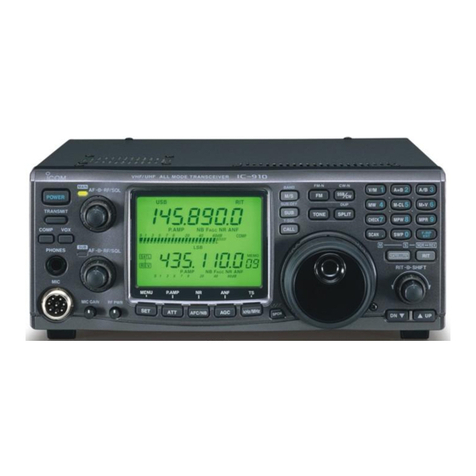
Icom
Icom IC-910H User manual
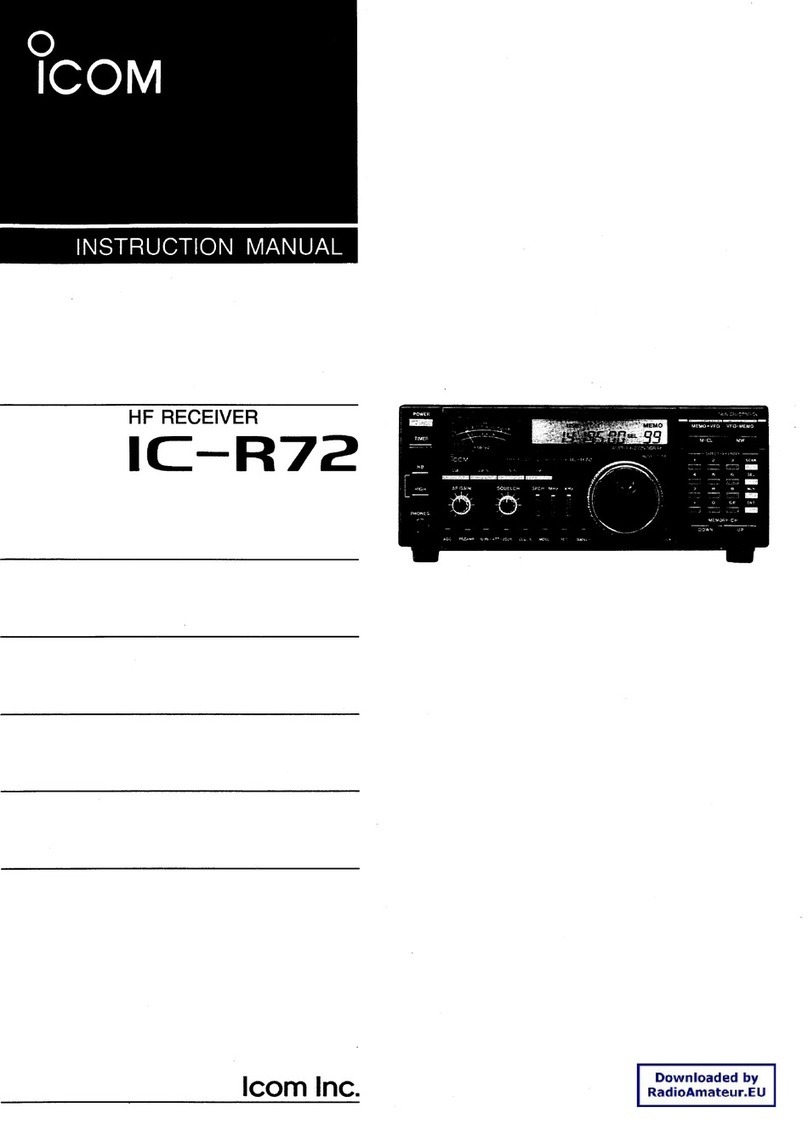
Icom
Icom IC-R72 User manual
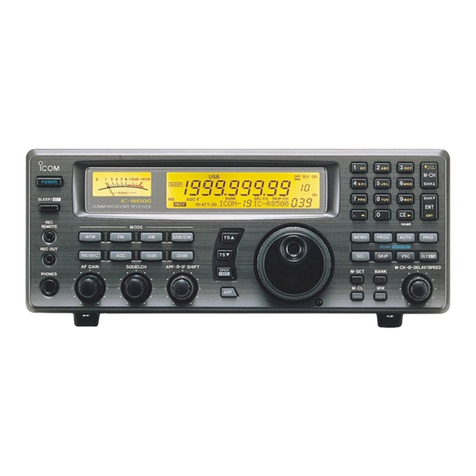
Icom
Icom iC- r8500 User manual
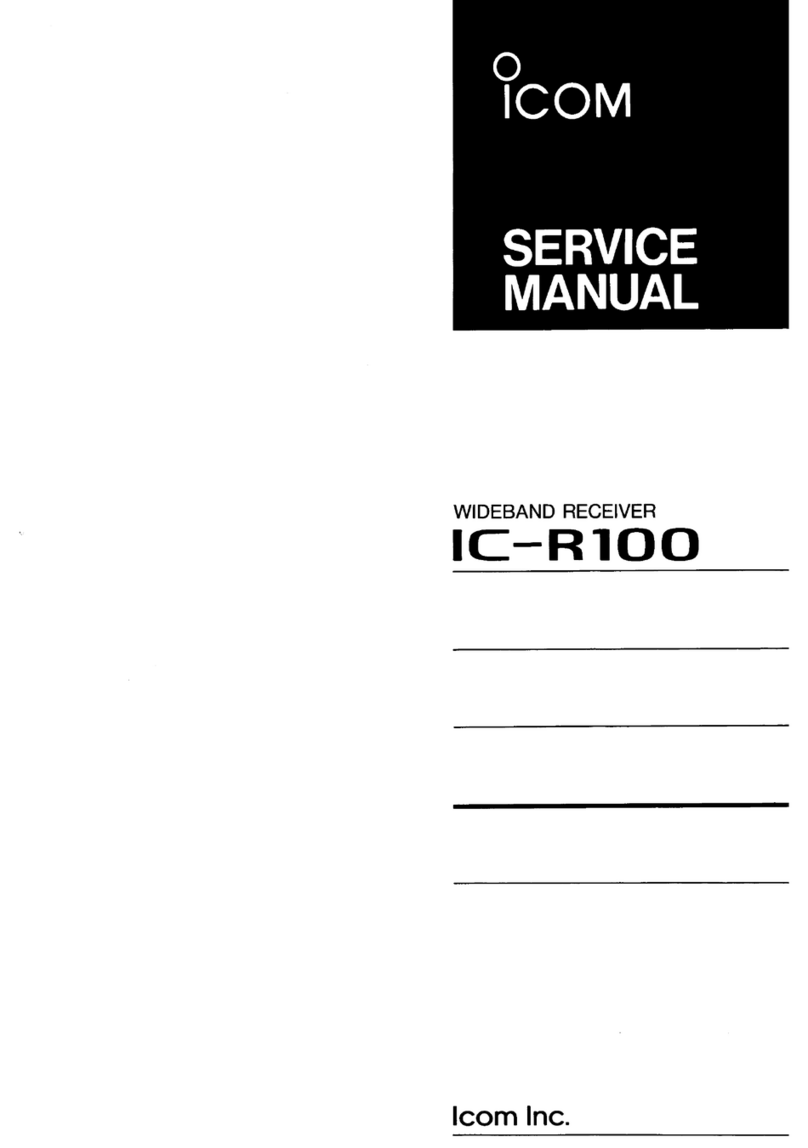
Icom
Icom IC-R100 User manual
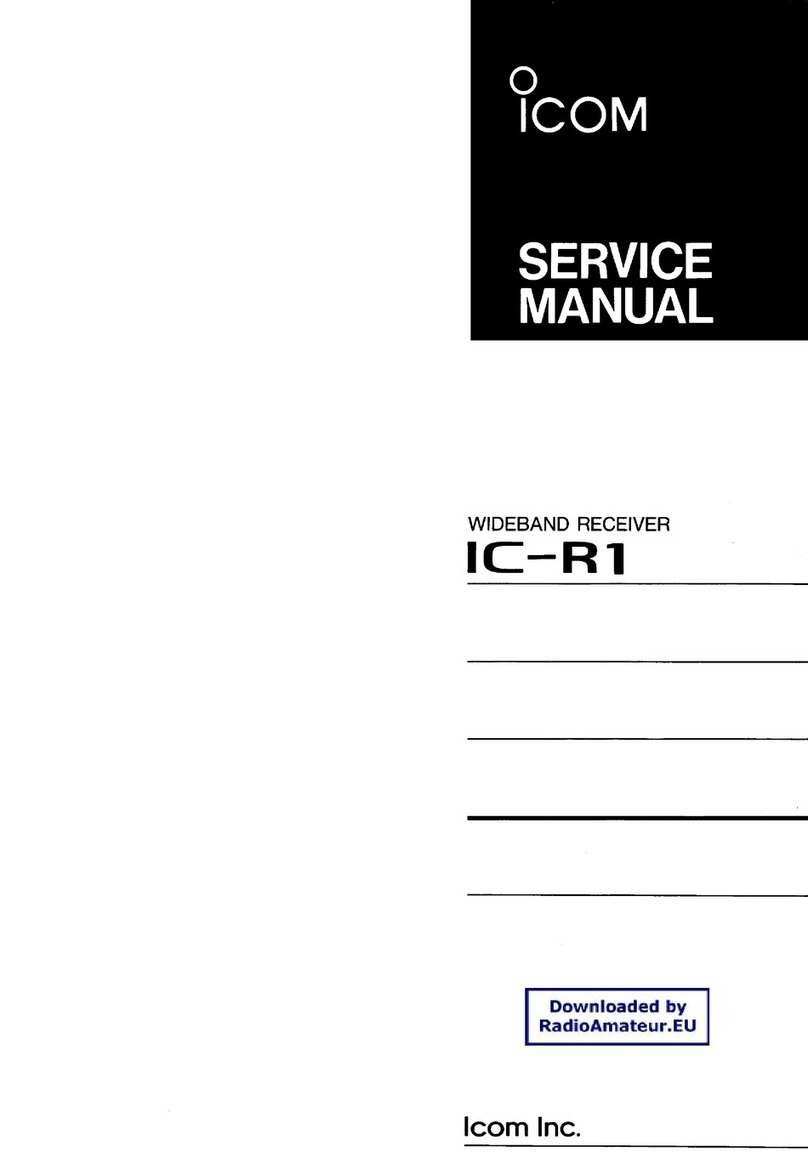
Icom
Icom IC-R1 User manual
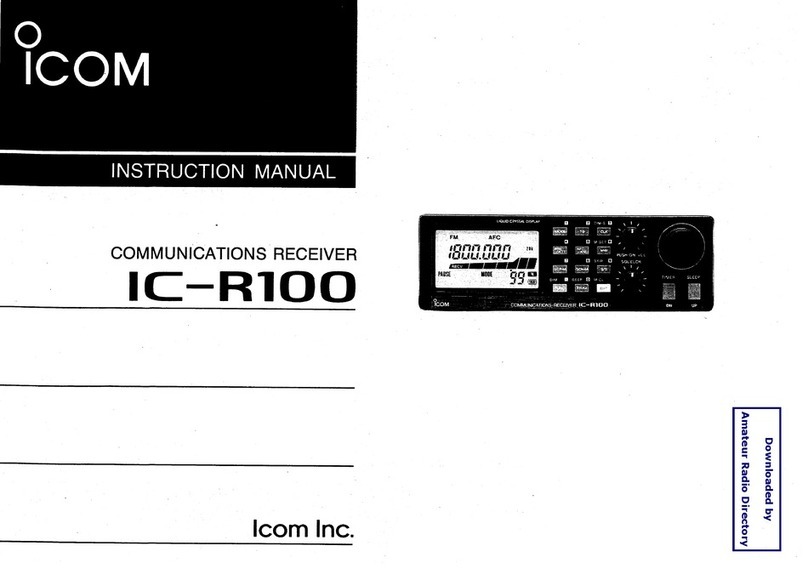
Icom
Icom IC-R100 User manual
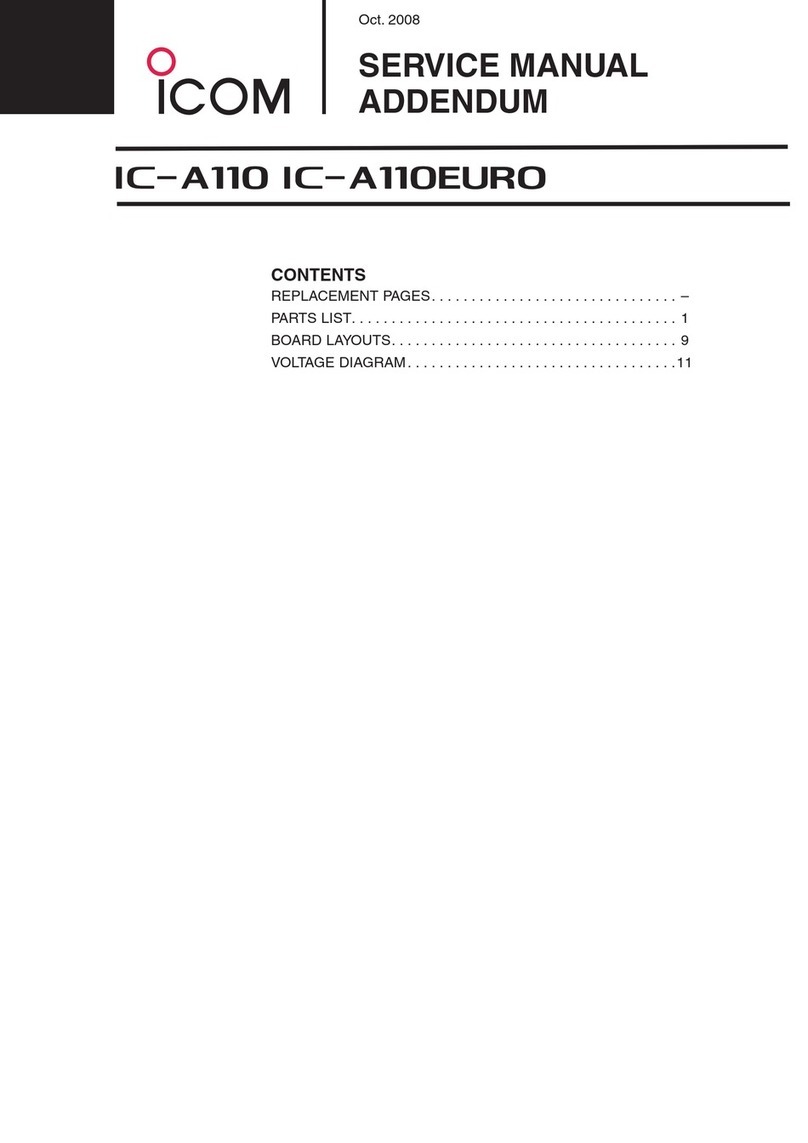
Icom
Icom IC-A110EURO Installation and operating instructions

Icom
Icom iC- r8500 Installation and operating instructions
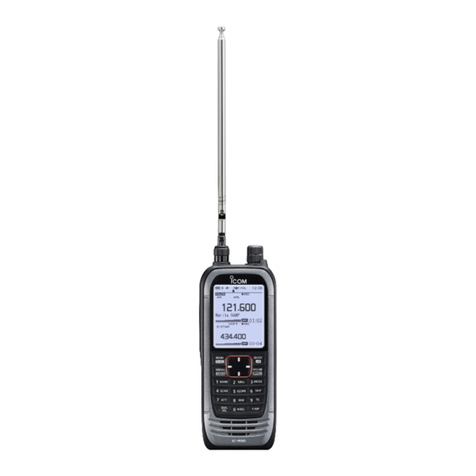
Icom
Icom IC-R30 Installation guide
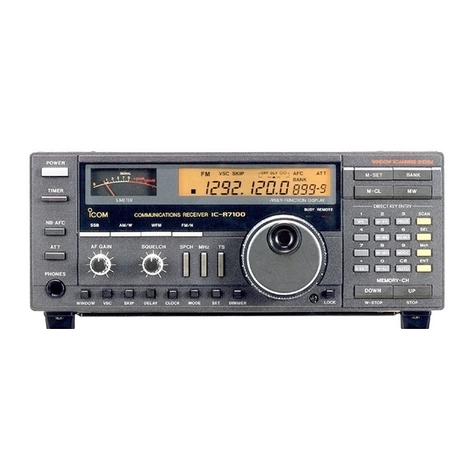
Icom
Icom IC-R7100 User manual
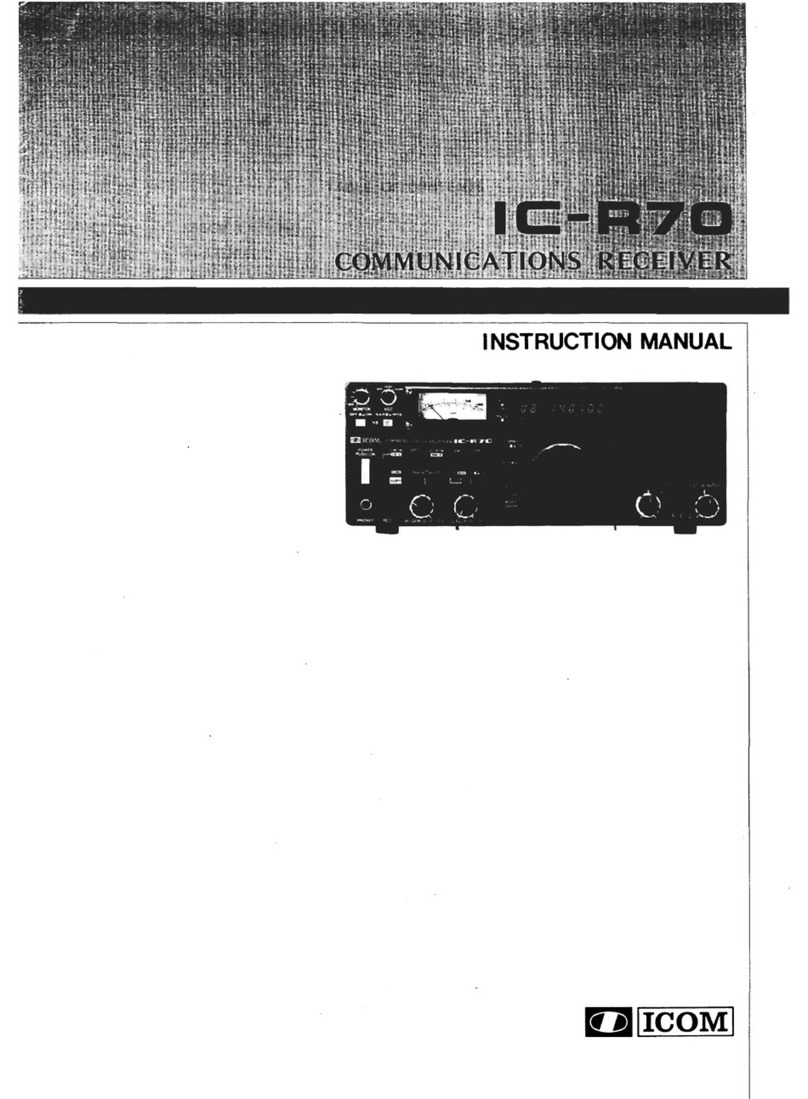
Icom
Icom IC-R70 User manual
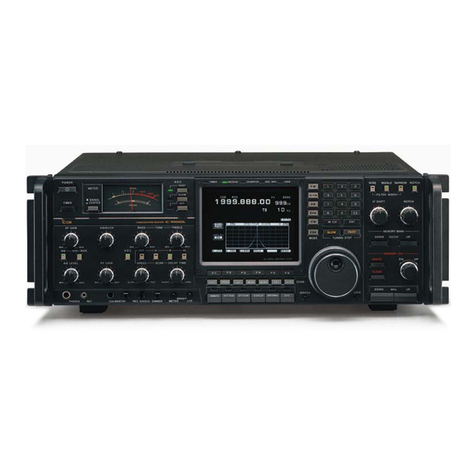
Icom
Icom IC-R9000L User manual

Icom
Icom FP-561 User manual
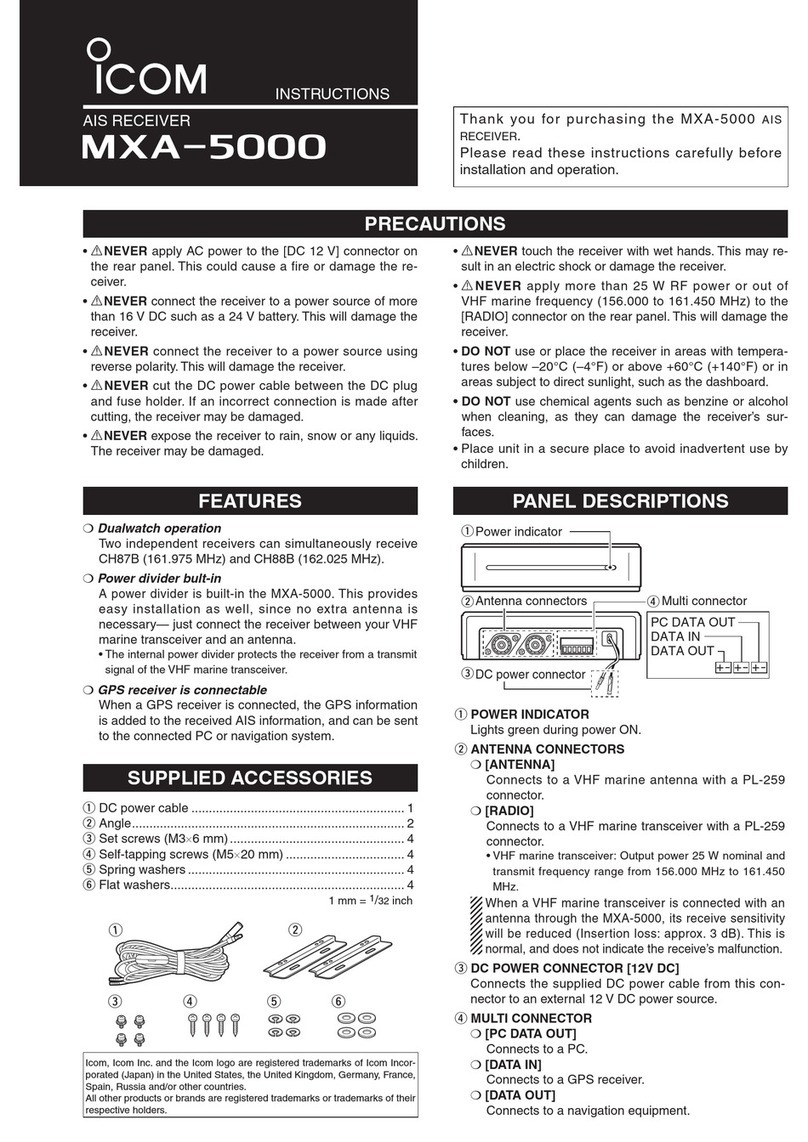
Icom
Icom MXA-5000 User manual
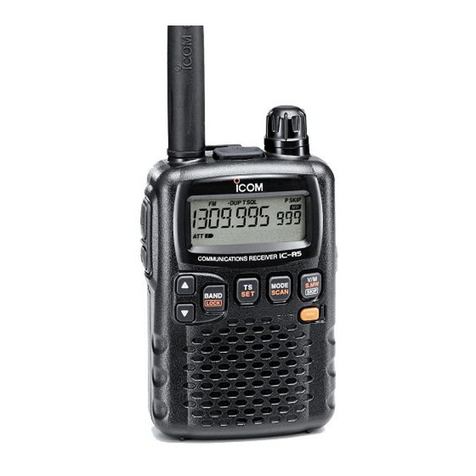
Icom
Icom IC-R5 User manual
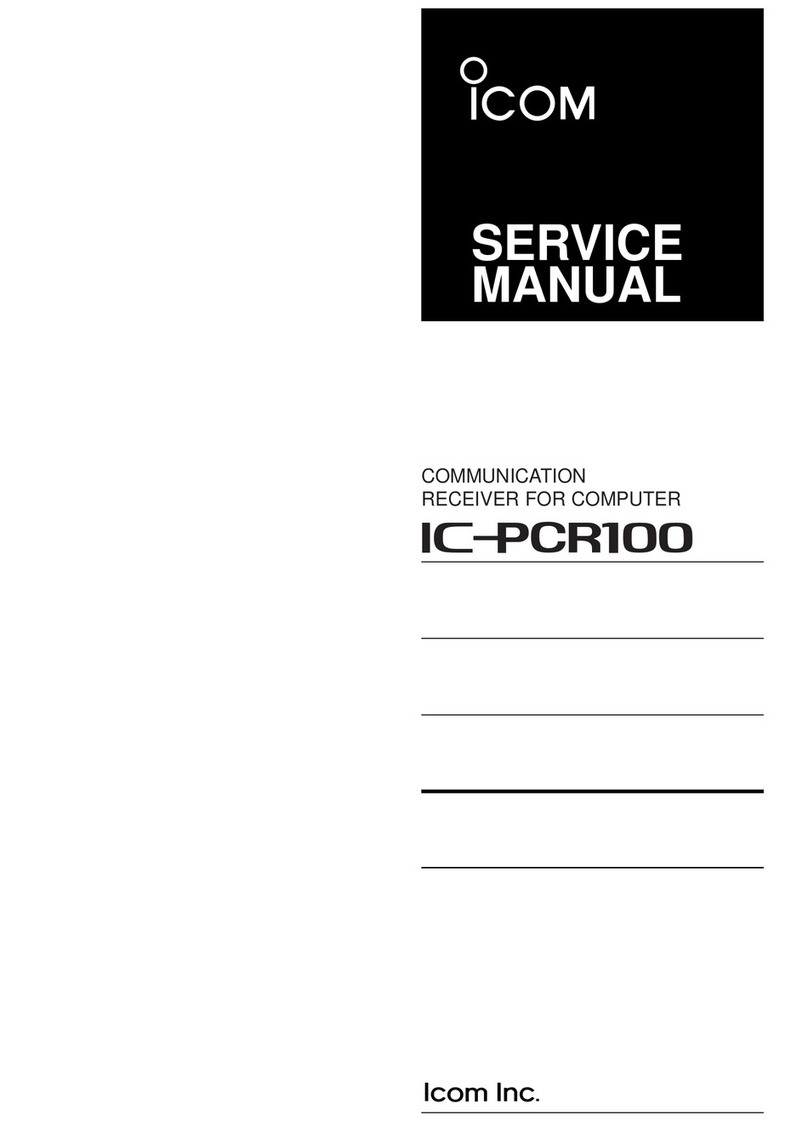
Icom
Icom COMMUNICATION RECEIVER IC PCR100 User manual
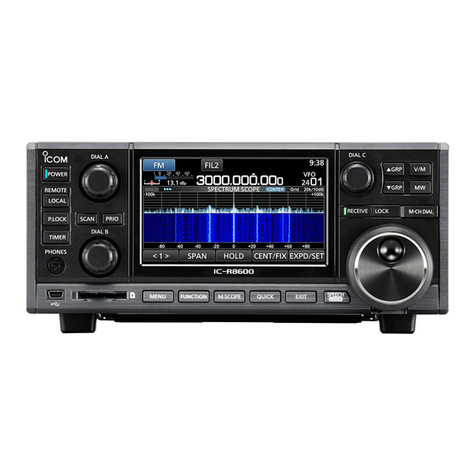
Icom
Icom IC-R8600 Administrator Guide
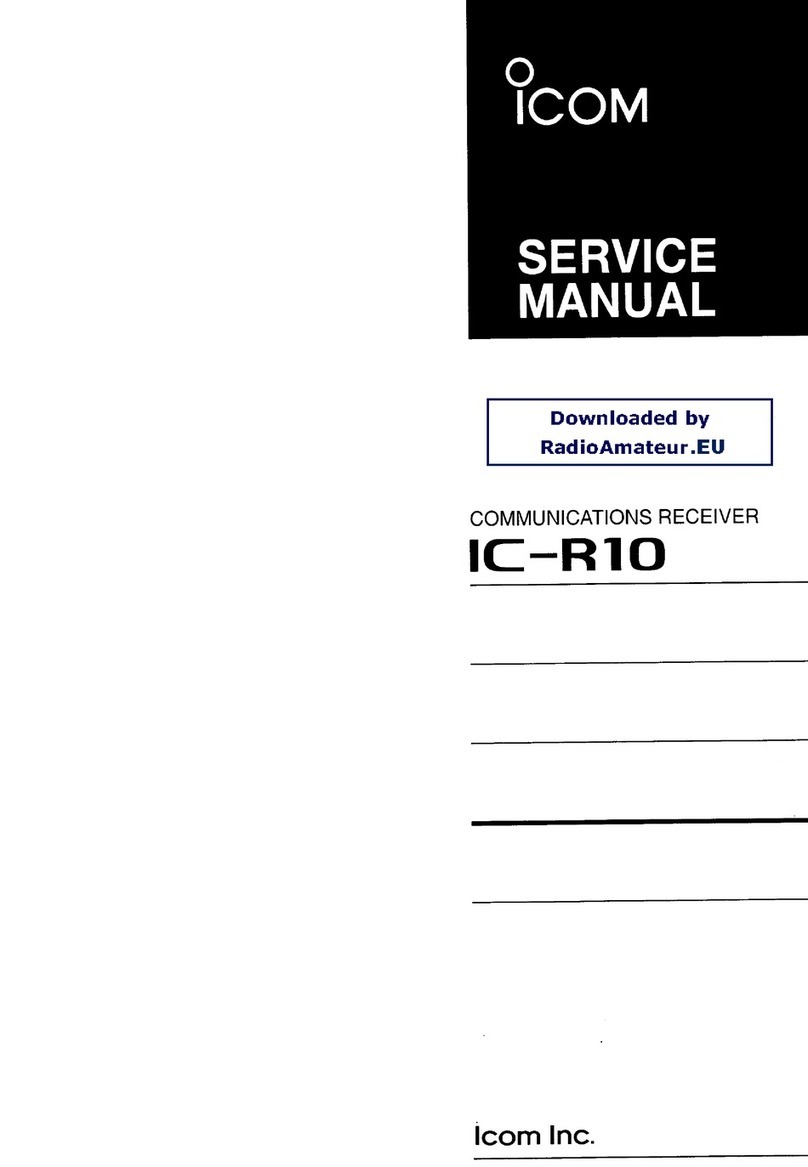
Icom
Icom IC-R10 User manual

Icom
Icom IC-RX7 User manual

Icom
Icom iC- r8500 User manual
